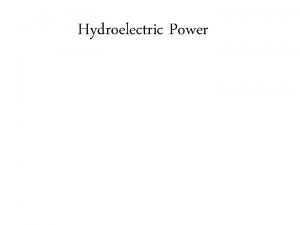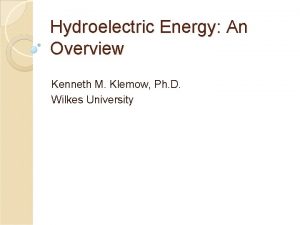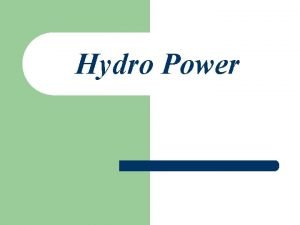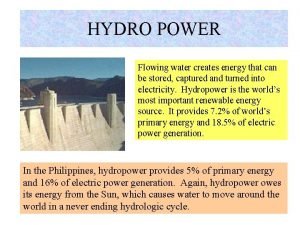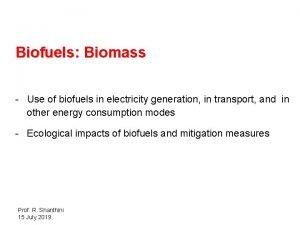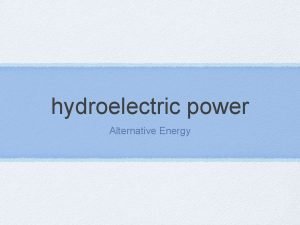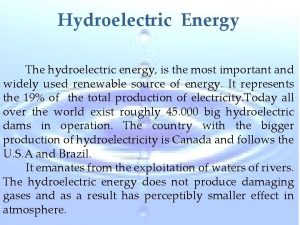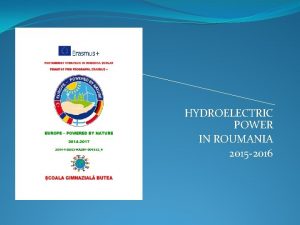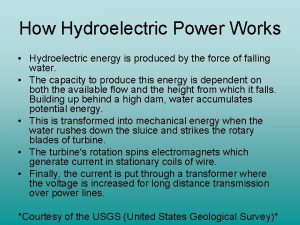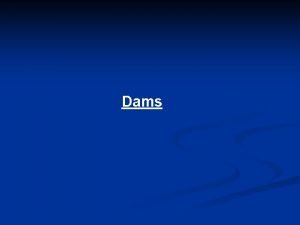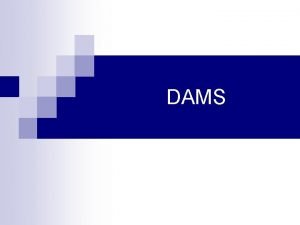ELECTRICITY GENERATION A Close Look at Hydroelectric Dams











- Slides: 11

ELECTRICITY GENERATION A Close Look at Hydroelectric Dams, Generators and Coal Power Plants

Electrical Generation � � Generators create electricity when their internal components (rotors) rotate within their external housing (stator) This rotation requires some form of power to spin the generator shaft. Most power plants use a turbine blade to rotate the shaft. A source of power is required to rotate the turbines. Turbine and Generator

Power Sources � Coal � Wind � Nuclear � Hydroelectric � Oil � Solar � Wood � Tidal � Geothermal Non-renewable Sources Renewable Sources

How A Hydroelectric Dam Works � The dam builds up a reservoir of water. � This reservoir is higher up than the next portion of the river/waterway. � The dam opens up and lets water flow down the penstock. � At the bottom of the penstock is a turbine blade. � As the water flows across the turbine, the blade spins. This in turn spins the generator shaft.

Hydroelectric Dam Continued � The faster the generator shaft spins, the faster the internal components in the generator spin. � This rotational energy is then transformed into electrical energy. � The amount of energy a dam can use is controlled by the height of the dam, or the volume of water that flows through a dam. � There is little, to no emissions caused by a dam. � However, dams interfere with natural waterways and/or flood large expanses of land.

Electricity flows through power lines forebay transformer screen generator penstock generator shaft turbine tailrace river A Hydroelectric Dam The water flows down the penstock, spins the turbine and exits through the tailrace. This is a relatively clean source of electricity with little to no emissions.

Coal Power Plants � Coal plants burn coal to create electricity. � The burning coal heats up a water boiler. � The boiling water turns into steam. � This steam is directed towards turbine causing the turbine to spin (see dam note). � The power output can be controlled by the amount of coal being burned and the volume of steam flowing through the system. � The steam is then condensed back into water to be used again.

Video for Hydroelectric Generation � https: //www. youtube. com/watch? v=Lx 6 Ufi. EU 3 Q 0

Pros and Cons of Coal � Pros: Currently coal is cheap and we have plenty of it. � Cons: Creates a lot of carbon dioxide and can produce sulfer dioxide which turns into sulfuric acid (acid rain) � Coal mining can be environmentally damaging. Coal Plant Smoke Stacks

Strip Mining Coal Pit

Coal Powered Electricity Plant The burning coal heats the water in the boiler. The steam it creates spins the turbine which rotates the generator shaft. This source of power creates harmful emissions.
 Left right look
Left right look Purdom power plant
Purdom power plant Economic benefits of hydroelectric power
Economic benefits of hydroelectric power Hydropower
Hydropower Impoundment facility
Impoundment facility Geothermal energy advantages and disadvantages
Geothermal energy advantages and disadvantages Context clues synonyms and antonyms
Context clues synonyms and antonyms Static electricity and current electricity
Static electricity and current electricity Current electricity
Current electricity Electricity and magnetism vocabulary
Electricity and magnetism vocabulary Biomass electricity generation
Biomass electricity generation First generation antipsychotics vs second
First generation antipsychotics vs second

